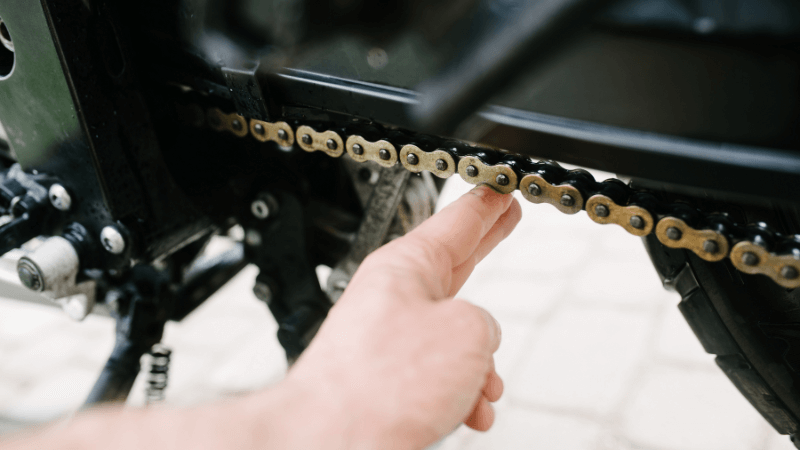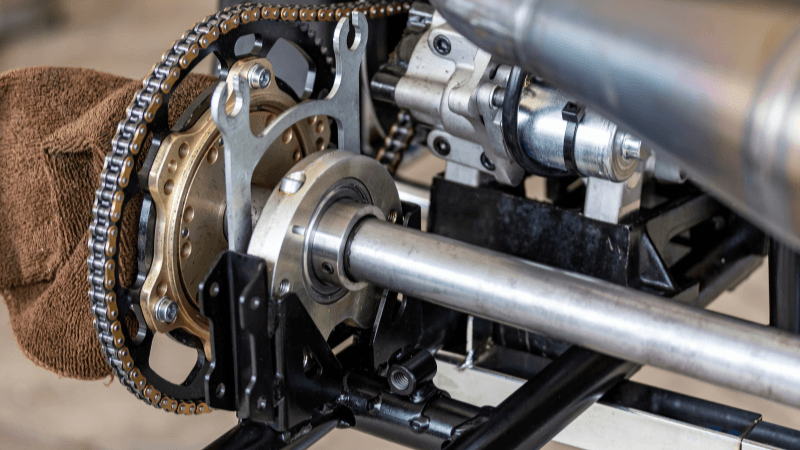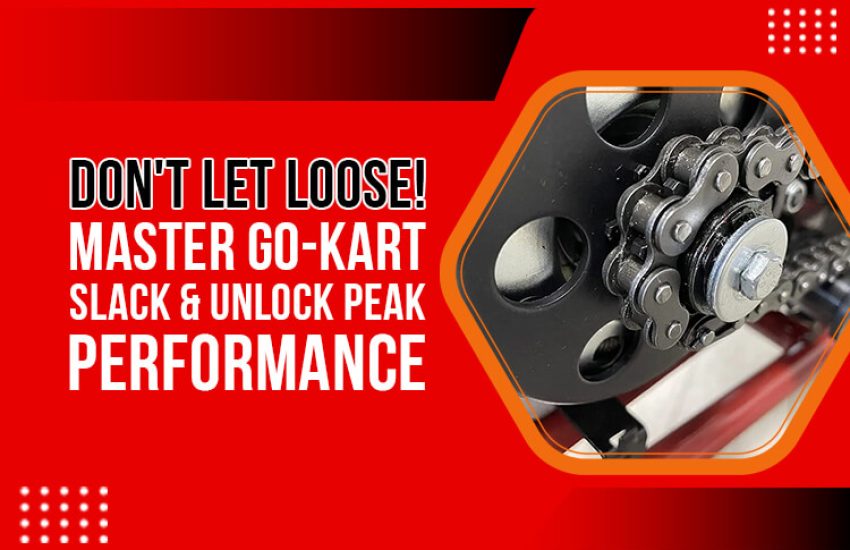As a beginner or a seasoned pro, have you ever wondered about the ideal amount of slack needed for your go-kart chain?
Your go-kart chain should be tight enough so that it doesn’t dislodge when the engine is running, which typically equates to slack between 1/4″ or 3/8”. A chain that’s too tight can lead to several issues and a chain that’s too loose can cause reduced performance and safety concerns.
In this article, I’ll cover important questions, including: How much slack should a go-kart chain have? What is chain slack? How to check chain slack? And how to prevent go-kart chain issues?
Table of Contents
ToggleUnderstanding Chain Slack
- Often referred to as flex or play, go-kart chain slack is the amount of looseness in the chain when the go-kart is at rest.
- Maintaining the right amount of chain slack is highly important for several reasons. Too much play on the chain can lead to issues like skipping and slipping. It can also cause potential damage to the chain and sprockets.
Too little slack can cause excessive tension, increased wear, and potential overheating.
How Tight Should A Go-Kart Chain Be
The ideal slack for a go-kart chain varies across kart models, types, and manufacturers. Regardless, here are a few typical recommendations for different types of go-karts and riding styles.
- Recreational go-karts – 1/4 inch to 1/2 inch (6 to 13 mm)
- Performance go-karts – 1/8 inch to 1/4 inch (3 to 6 mm)
- Off-Road go-karts – 1/2 inch to 3/4 inch (13 to 19 mm)
- Electric go-karts – 1/4 inch to 1/2 inch (6 to 13 mm)
A bunch of things affect how tight your go-kart chain needs to be, mainly the type of chain, sprocket size, and even the size of your go-kart.
- Chain type – there are many different types of go-kart chains, each with its tension requirements. Standard roller go-kart chains typically require a slack between 1/4 inch to 1/2-inch. O-ring chains need around 1/4 inch to 1/2-inch. Chains without the sealed rings require 1/4 inch to 1/2 inch slack. #35, #40, #41 and #420 chains need between 1/4 inch to 1/2 inch slack. The amount depends on the specific chain and go-kart model.
- Sprocket size – the size of the sprockets directly influences the amount of tension required in the go-kart chain.
- Go-kart size and weight – the size and weight of your go-kart play a pivotal role in the tension requirements of the chain.
The size and weight of a go-kart affect the force applied on the chain, which consequently influences the required tension. For example, larger and heavier go-kart models may demand higher chain tension. This ensures effective power transmission and performance.
| Type of Go-Kart | Recommended Chain Slack Range |
| Recreational Go-Karts | 1/2″ to 3/4 |
| Off-Road Go-Karts | 1/4″ and 3/8″ |
| Electric Go-Karts | Less than 1/2 inch |
Checking Chain Slack
Even though there are many ways to check the chain slack of your go-kart, a chain slack gauge is easy to use and will provide accurate readings.
- Tools you will need – a go-kart chain slack gauge like Chain Monkey. Here’s how to use Chain Monkey.
- The first thing to do is configure your Chain Monkey. The good news is that you will only have to do this once, after which your Chain Monkey will be set to your go-kart’s required tension.
- After hooking on and tightening Chain Monkey on your go-kart’s chain, you will notice an arc, which is the amount of excess flex in your chain.
- Some go-kart models also come with a chain tensioner built into the body of the machine, which you can adjust with a flat-blade screwdriver.
The biggest reason to use a high-quality chain slack gauge is for accurate readings every time.
Furthermore, a high-quality chain slack gauge like Chain Monkey provides consistently accurate results. It is already configured to your go-kart’s slack requirements. This allows you to set the play of your go-kart chain over time.
It’s easy to make common mistakes when using a chain slack gauge. Mistakes include measuring at the wrong point, incorrect gauge placement, and using a poor-quality or worn-out gauge. Here are a few tips on how to avoid these mistakes.
- Measuring at the wrong point – always measure the chain slack in the middle, which is the point between the clutch and the driven sprocket.
- Using a poor-quality or worn-out gauge – it’s best to steer clear of cheap go-kart chain slack gauges. Check your chain slack gauge periodically for wear and tear, and replace it with a new, high-quality gauge if it shows signs of damage.
- Incorrect gauge placement – it’s important to place the chain slack gauge around the chain correctly.
Adjusting Chain Tension

Adjusting the chain tension of your go-kart is an essential maintenance task. You should perform it after a few weeks of use or when you feel a dip in performance. The process entails:
- Parking your go-kart on a flat surface and turning it off.
- Using Chain Monkey to determine the current flex in the chain. If there is no arc, no adjustments to the play are needed, but any arc should be tightened.
- The process of adjusting the chain tension varies across go-kart models. So, refer to your manufacturer’s guidelines.
You’ll need wrenches and a go-kart slack gauge to adjust the chain tension of your go-kart. Take note that the process to adjust the slack may vary across manufacturers but here are the most common steps.
- Park on a level surface and turn the go-kart off.
- Locate the rear axle adjustment mechanism, which could be an eccentric collar, sliding axle, or other adjustment system.
- Measure the chain slack using the chain slack gauge. Compare the results with the manufacturer’s recommended range. If you’re using Chain Monkey, you simply need to clamp the tool onto the chain and make the necessary adjustments.
- The process of loosening or tightening the chain can vary. In most cases, the chain can be tightened by pushing the engine forward until the chain is tight.
- Now, gently pinch the top and bottom of the middle of the chain loop together, very gently, just to drag the engine back a notch. Then tighten it up and check the slack.
- Refer to your owner’s manual for the right process or get professional help.
Maintaining Optimal Chain Performance
Apart from adjusting the slack of your go-kart’s chain, there are a few other things to keep in mind for optimal chain performance and longevity.
- Familiarize yourself with the manual – No go-kart manufacturer guidelines on use and maintenance are the same. It’s important to read your owner’s manual thoroughly and follow the recommendations on chain slack range, maintenance, and adjustments.
- Protect your go-kart from the elements – if storing your go-kart in the winter or for extended periods, cover it and store it in a dry place to prevent rust.
- Keep it clean – clean the exterior body and interior components regularly to remove any dirt and debris.
- Check alignment – Misaligned wheels can affect chain performance. Ensure that the rear wheels are properly aligned.
- Check chain tension frequently – Use a high-quality chain slack gauge to ensure it falls within the manufacturer’s recommended range. Improper tension can lead to wear, noise, and reduced efficiency.
As the saying goes, “Prevention is better than cure.” Perform the following tasks to ensure long-lasting chain health and prevent premature wear.
- Regular inspection – Regularly inspect the chain for signs of wear, damage, or any loose components. Look for tight spots, rust, or any bent links, and examine the sprockets for wear and ensure they are aligned properly.
- Avoid excessive speeds – Excessive speeds can put extra stress on the chain and sprockets. Ride at speeds appropriate for your go-kart’s design and intended use.
- Periodic replacements – just as most other components, go-kart chains are prone to wear and tear and do need periodic replacements.
If you notice significant wear, elongation, or other issues, consider replacing the chain as part of regular maintenance.
Additionally, always buy a high-quality chain from reputable manufacturers. They can resist wear and last longer.
- Professional maintenance – Many go-kart users skimp on professional maintenance to save costs. Regardless, it’s worth it, especially if you use your go-kart frequently or for competitive racing.
- Appropriate lubrication – Apply a high-quality chain lubricant to the chain after cleaning. Lubricate according to the manufacturer’s recommendations or more frequently if you ride in dusty or wet conditions.
However, avoid excess lubrication as it can attract dirt and debris, leading to accelerated wear. Wipe off excess lubricant after application.
Using high-quality lubricants specifically designed for go-kart chains is crucial. It affects the performance, longevity, and safety of the go-kart.
There are a few key reasons to use the right lubricants for your go-kart chain. They include reduced friction, wear protection, corrosion prevention, and temperature stability.
I’ve tried many chain lubes. I started with DuPont dry chain lube and sticky paste. But the Motul Chain Lube attracts less dirt and provides great protection.
Preventing Chain Issues

Improper go-kart tension and irregular maintenance can lead to an array of issues. These issues can affect the performance, safety, and durability of the machine. Common issues you may experience include:
- Chain slippage – incorrect chain tension is perhaps the biggest cause of chain slippage in go-karts owing to the chain not engaging with the sprockets properly.
The good news is that chain slippage is easy to fix by simply adjusting the chain tension according to the manufacturer’s specifications.
- Worn out or damaged sprockets – Go-kart sprockets are bound to wear out over time. Yet, improper chain tension and lack of lubrication can speed up this process.
Damaged sprockets can result in poor chain engagement. This can lead to reduced efficiency and damage to both the chain and sprockets.
- Noise and vibrations – let’s face it —no one wants to ride around in a noisy go-kart, a problem that can be attributed to incorrect chain tension.
Apart from chain tension, vibrations and noises in go-karts can be caused by worn or damaged sprockets, loose components, worn bearings, and wheel imbalance.
If you inspect the components of your go-kart frequently, you’ll be able to identify these underlying issues before they become a major problem.
The previous issues can be easily prevented with measures such as:
- Regular chain inspection – Regularly inspecting the chain can help prevent several major long-term problems. I can’t emphasize this enough. Inspect the chain for signs of wear, damage, or tension issues and correct them promptly to prevent further damage.
- Proper chain lubrication – Make sure your go-kart’s chain and other components are well-lubricated with a high-quality chain lubricant.
- Avoid harsh driving conditions – It’s tempting, but drive your go-kart in favorable conditions. Avoid aggressive driving, sudden acceleration, and harsh braking. This reduces wear on the chain and other components.
- Follow the manufacturer’s maintenance schedule – Follow the guidelines in the go-kart’s manual for routine maintenance tasks.
If you aren’t sure how to perform routine checks or for more complex chain problems, it’s best to seek professional help.
Professional mechanics have the expertise to diagnose and identify complex go-kart chain problems. These issues may not be clear to an amateur.
The Golden Rule Of Go-Kart Chain Slack: Keep It Chill, Not Loose!
Phew, we covered a lot about that chain slack, didn’t we? So, the burning question remains: just how much wiggle room does your go-kart chain need? Well, most of the time, you’re looking at somewhere between a quarter and three-eighths of an inch. Think of it like a friendly handshake – not too tight, not too loose, just enough to feel secure.
Remember, proper chain tension is like the secret sauce for your go-kart. It keeps everything running smooth, prevents annoying chain slip, and helps those sprockets last longer than a worn-out tire. So, do yourself a favor: check that slack regularly, lube it like you mean it, and give those wheels some TLC. It’ll pay off in smoother rides, happier chains, and more epic go-kart adventures.
Now get out there and tear up the track! (But safely, of course.)



